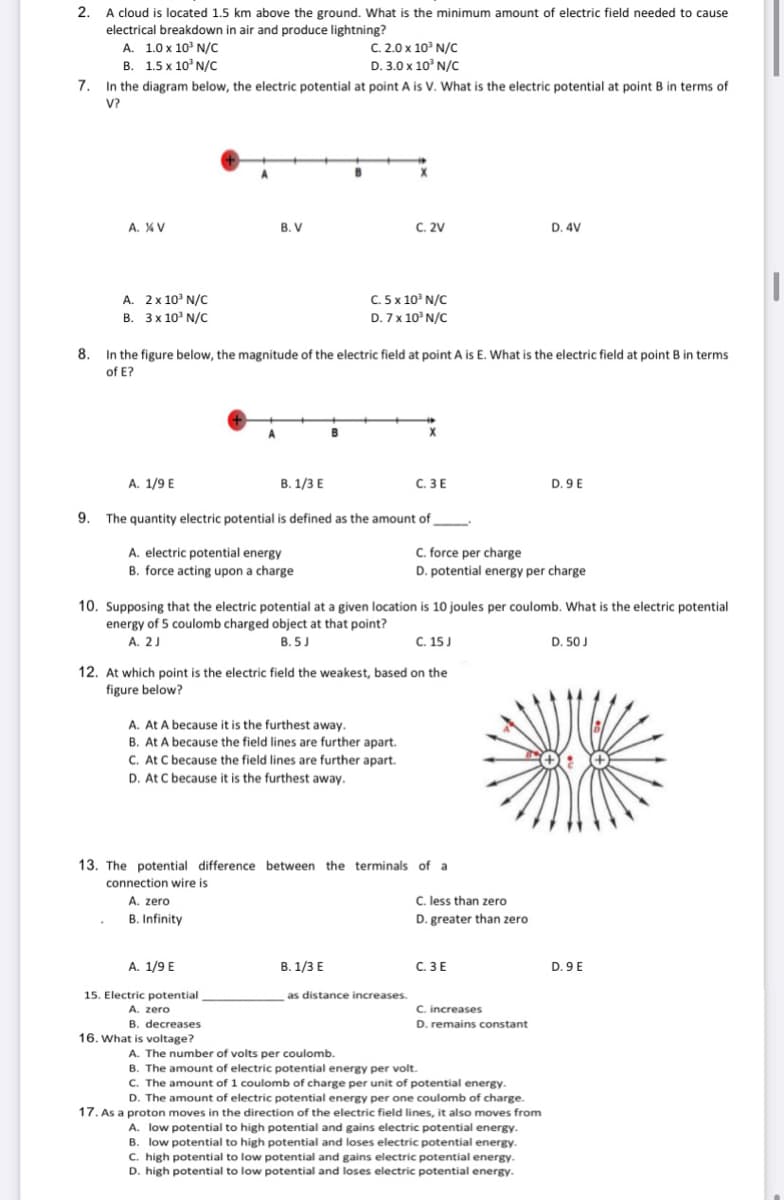2. A cloud is located 1.5 km above the ground. What is the minimum amount of electric field needed to cause electrical breakdown in air and produce lightning? A. 1.0 x 10' N/C В. 15х 10°N/C 7. In the diagram below, the electric potential at point A is V. What is the electric potential at point B in terms of C. 2.0 x 10° N/C D. 3.0 x 10° N/C V? A. %V B. V C. 2V D. 4V A. 2x 10' N/C B. 3x 10° N/C C.5 x 10° N/C D. 7x 10° N/C 8. In the figure below, the magnitude of the electric field at point A is E. What is the electric field at point B in term of E? A. 1/9 E В. 1/3 Е С. ЗЕ D. 9 E
2. A cloud is located 1.5 km above the ground. What is the minimum amount of electric field needed to cause electrical breakdown in air and produce lightning? A. 1.0 x 10' N/C В. 15х 10°N/C 7. In the diagram below, the electric potential at point A is V. What is the electric potential at point B in terms of C. 2.0 x 10° N/C D. 3.0 x 10° N/C V? A. %V B. V C. 2V D. 4V A. 2x 10' N/C B. 3x 10° N/C C.5 x 10° N/C D. 7x 10° N/C 8. In the figure below, the magnitude of the electric field at point A is E. What is the electric field at point B in term of E? A. 1/9 E В. 1/3 Е С. ЗЕ D. 9 E
Physics for Scientists and Engineers, Technology Update (No access codes included)
9th Edition
ISBN:9781305116399
Author:Raymond A. Serway, John W. Jewett
Publisher:Raymond A. Serway, John W. Jewett
Chapter25: Electric Potential
Section: Chapter Questions
Problem 25.54AP: Review. In fair weather, the electric field in the air at a particular location immediately above...
Related questions
Question
Most of these questions, I’m pretty sure, that you can answer po without solving. Hoping you can help a student in need. Thank you so much!

Transcribed Image Text:2. A cloud is located 1.5 km above the ground. What is the minimum amount of electric field needed to cause
electrical breakdown in air and produce lightning?
A. 1.0 x 10° N/C
В. 1.5х 10' N/C
C. 2.0 x 10' N/c
D. 3.0 x 10° N/C
7. In the diagram below, the electric potential at point A is V. What is the electric potential at point B in terms of
V?
X
B. V
C. 2V
D. 4V
A. %V
A. 2x 10' N/C
B. 3x 10' N/C
C. 5 x 10° N/C
D. 7x 10° N/C
8. In the figure below, the magnitude of the electric field at point A is E. What is the electric field at point B in terms
of E?
A
B
A. 1/9 E
B. 1/3 E
C. 3E
D. 9 E
9. The quantity electric potential is defined as the amount of
A. electric potential energy
B. force acting upon a charge
C. force per charge
D. potential energy per charge
10. Supposing that the electric potential at a given location is 10 joules per coulomb. What is the electric potential
energy of 5 coulomb charged object at that point?
A. 2J
B. 5J
C. 15 J
D. 50 J
12. At which point is the electric field the weakest, based on the
figure below?
A. At A because it is the furthest away.
B. At A because the field lines are further apart.
C. At C because the field lines are further apart.
D. At C because it is the furthest away.
13. The potential difference between the terminals of a
connection wire is
A. zero
C. less than zero
B. Infinity
D. greater than zero
A. 1/9 E
В. 1/3 Е
C. 3E
D. 9 E
as distance increases.
15. Electric potential
A. zero
B. decreases
16. What is voltage?
C. increases
D. remains constant
A. The number of volts per coulomb.
B. The amount of electric potential energy per volt.
C. The amount of 1 coulomb of charge per unit of potential energy.
D. The amount of electric potential energy per one coulomb of charge.
17. As a proton moves in the direction of the electric field lines, it also moves from
A. low potential to high potential and gains electric potential energy.
B. low potential to high potential and loses electric potential energy.
C. high potential to low potential and gains electric potential energy.
D. high potential to low potential and loses electric potential energy.
Expert Solution
This question has been solved!
Explore an expertly crafted, step-by-step solution for a thorough understanding of key concepts.
Step by step
Solved in 3 steps

Knowledge Booster
Learn more about
Need a deep-dive on the concept behind this application? Look no further. Learn more about this topic, physics and related others by exploring similar questions and additional content below.Recommended textbooks for you

Physics for Scientists and Engineers, Technology …
Physics
ISBN:
9781305116399
Author:
Raymond A. Serway, John W. Jewett
Publisher:
Cengage Learning

Physics for Scientists and Engineers
Physics
ISBN:
9781337553278
Author:
Raymond A. Serway, John W. Jewett
Publisher:
Cengage Learning

Physics for Scientists and Engineers with Modern …
Physics
ISBN:
9781337553292
Author:
Raymond A. Serway, John W. Jewett
Publisher:
Cengage Learning

Physics for Scientists and Engineers, Technology …
Physics
ISBN:
9781305116399
Author:
Raymond A. Serway, John W. Jewett
Publisher:
Cengage Learning

Physics for Scientists and Engineers
Physics
ISBN:
9781337553278
Author:
Raymond A. Serway, John W. Jewett
Publisher:
Cengage Learning

Physics for Scientists and Engineers with Modern …
Physics
ISBN:
9781337553292
Author:
Raymond A. Serway, John W. Jewett
Publisher:
Cengage Learning

College Physics
Physics
ISBN:
9781285737027
Author:
Raymond A. Serway, Chris Vuille
Publisher:
Cengage Learning

College Physics
Physics
ISBN:
9781305952300
Author:
Raymond A. Serway, Chris Vuille
Publisher:
Cengage Learning

Principles of Physics: A Calculus-Based Text
Physics
ISBN:
9781133104261
Author:
Raymond A. Serway, John W. Jewett
Publisher:
Cengage Learning